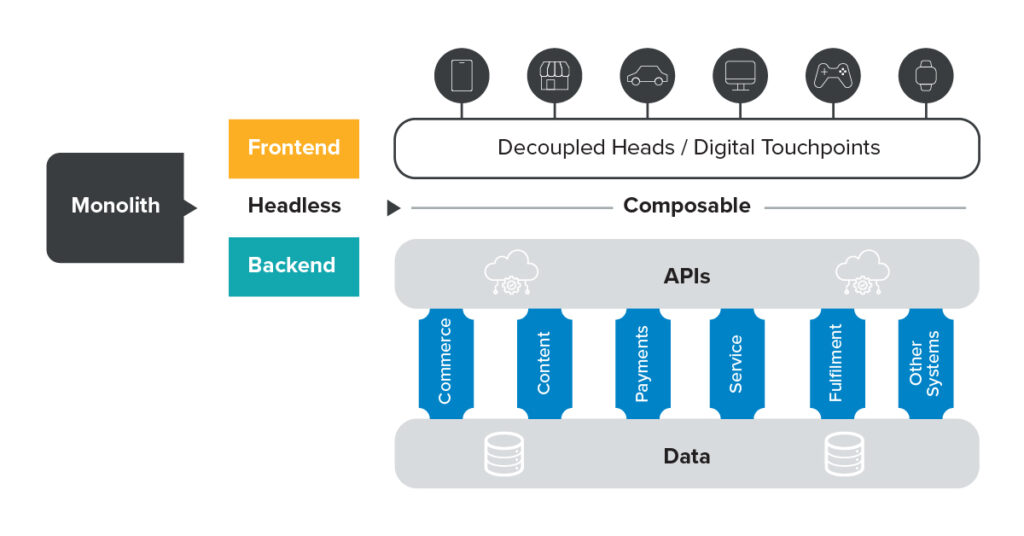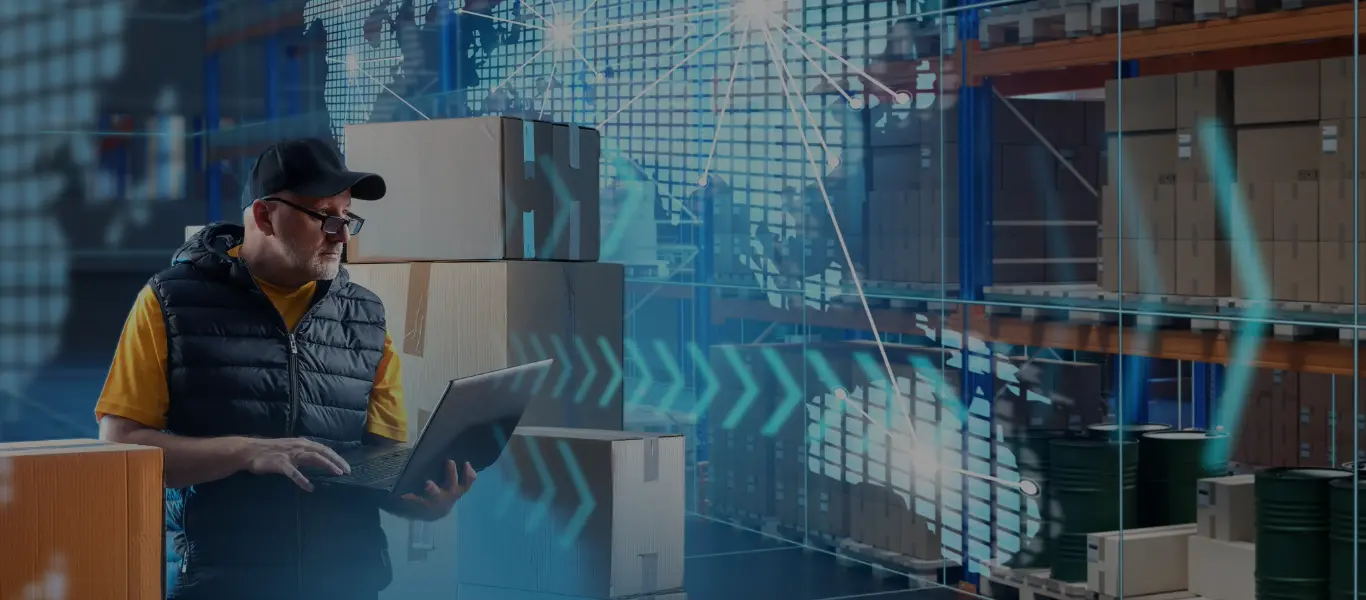Introduction to Monolithic, Headless, and Composable Commerce
Enterprise companies whose eCommerce websites are powered by traditional, monolithic architectures have two primary considerations to make when modernizing their tech stacks to best meet their unique needs and strategic goals: optimize their legacy monolith or leverage more modern architectures by going headless or re-platforming to a composable commerce solution. So, which is the best way to go?
This 3-part series offers decision-makers critical insights and a simple framework for comparing these options in order to make the best possible decisions for their organizations. Part 2 focuses on how each architecture directly impacts core business functions, UX and CX, while Part 3 dives into the more strategic and long-term planning considerations involved in determining which is the right architecture for your business.
DEFINING MONOLITHIC, HEADLESS, AND COMPOSABLE
Before diving directly into this topic, it’s important to first define these architectures clearly. “Headless vs composable commerce” is a frequently searched phrase because there’s still a fair amount of confusion about what exactly these newer buzzwords mean, and how they differ from both one another and traditional, monolithic platforms. Adding to this confusion, some monoliths are embracing elements of headless and composability – without being fully either – making it even more difficult for buyers to decipher and evaluate their options.
Defining Monolithic Commerce Architecture
This is the architecture that traditional, well-established eCommerce platforms were originally built on, like Oracle Commerce Cloud (formerly ATG), SAP Commerce Cloud (formerly Hybris), and Salesforce Commerce Cloud (formerly Demandware). A hallmark of this architecture is having all core functionalities tightly coupled together within a single codebase. Such platforms are also frequently referred to as all-in-one (AIO) suites or platforms. AIOs were the workhorses in the early days of digital commerce and still represent a majority of the market today, providing a single, self-contained software solution that combines all the features needed to run an online storefront under one roof – from things like product listings and shopping carts to payment processing, order fulfillment, and more. To use an analogy, think of a monolith as the Swiss Army Knife of digital commerce: all the essential tools you need are included in one solution, but none of them may be the absolute best tool available for their intended task.
Exploring Headless Commerce Solutions
In a departure from the all-in-one approach of monolithic architecture, a headless approach decouples the frontend presentation layer — the digital storefront that consumers interact with directly via various digital touchpoints, like design elements, layout, fonts, colors, images, product pages, menus, buttons, shopping cart, and checkout pages – from the backend, server-side business logic that operates behind the scenes and handles all the data and processes that make the storefront function smoothly (e.g., databases, inventory management, fulfillment, shipping, etc.). A headless commerce API bridges the gap, acting as an intermediary between the front- and backend, allowing them to communicate seamlessly while enabling independent development and deployment cycles as changes to one end don’t impact the other.
It’s important to note, however, that while a headless architecture does decouple the frontend from the backend, neither of the ends necessarily has to be a monolith. The backend could also be composed of microservices while the frontend could be composed of micro frontends, further amplifying the benefits of a modular design. But a microservices-based backend within a headless architecture shouldn’t be confused with composable architecture, as the latter demands a much higher degree of modularity.
An Overview of Composable Commerce Platforms
Composable commerce is often associated with MACH architecture, which adheres to a strict Microservices, API-first, Cloud-native, and Headless approach, but they’re not one and the same. However, MACH principles align well with the goals of composable commerce.
Composable commerce is a modern approach to building digital platforms that are flexible, scalable, and business-centric to enable the ultimate adaptability for an organization’s evolving needs. It is a software architecture that takes the concept of decoupling further than headless by breaking down the backend into modular, independent, and interchangeable services — microservices or Packaged Business Capabilities (PBCs) — that perform a specific task while offering well-defined APIs for seamless integration with other services. PBCs are simply microservices that are grouped together to address a specific business capability. Microservices or PBCs can be “composed” together through this concept of modular technologies, where components are like puzzle pieces that are designed to operate independently so that changes to one component don’t necessitate changes to others. The frontend then interacts with these composable services to build the final user experience
The highly modular design of composable architecture empowers organizations to more easily leverage their own development prowess to meet their unique needs, or easily integrate solutions from third-party vendors who offer robust, comprehensive functionality for the one thing they do for a “best-of-breed” approach. This is in contrast to monolithic architecture, where all components are tightly bundled together, or even a headless approach that leverages microservices for the decoupled backend, as some functionalities are often still bundled together. Complicating the choices for organizations even further, hybrid approaches are possible that might combine aspects of monolithic, microservices, and/or headless architectures, depending on their specific needs and capabilities.

WHICH ARCHITECTURE IS BEST SUITED FOR YOUR BUSINESS?
Monolithic:
While headless and composable architectures have numerous advantages over monolithic architecture, that in no way implies a monolith can’t be the right choice for some businesses. Generally speaking, monoliths can be a good choice for:
- Smaller Businesses with Simple Needs: If your business operates in a stable industry with limited requirements for functionalities and doesn’t anticipate rapid growth or frequent changes, a monolithic platform can be efficient and cost-effective.
- Businesses with Limited Technical Resources: A monolith can be easier to manage than a headless or composable solution for companies with smaller IT teams or budget constraints.
- Businesses with A Low Tolerance for Risk: If minimizing risk is crucial, the simpler change management required for a monolith might be preferred.
Optimizing a Monolithic Platform: For organizations that aren’t set up to manage headless or composable architectures, but want to maximize the value, performance, and functionality of their legacy monolithic platform, there are several ways a skilled systems integrator (SI) can help them optimize it:
- Performance: Over-customization can lead to performance bottlenecks. An SI can identify and refactor unnecessary customizations and implement best practices and standard extensions to streamline your setup. An SI can also leverage pre-built connectors, build robust APIs, and ensure data consistency across all systems to facilitate the process.
- Scalability and Flexibility: If your platform struggles to handle sudden surges in traffic or data, an SI can optimize your system architecture, implement cloud-based infrastructure, and leverage microservices for better scalability and flexibility.
- Personalization and Omnichannel: Built-in personalization features may not be enough for some businesses. An SI can implement advanced personalization tools, help you effectively utilize customer data, and ensure a consistent omnichannel experience.
- Maintenance and Support: Managing and maintaining the platform can be resource-intensive. An SI can establish clear maintenance processes, provide managed services, and offer dedicated support to ease the burden and help deliver better ROI.
Headless:
Organizations with legacy, monolithic eCommerce engines and robust IT capabilities can enable even greater flexibility, agility, and a better overall customer experience – while avoiding the change management and complexity involved with re-platforming to a composable solution – by integrating various headless components with their monolithic backend. A headless approach isn’t a one-size-fits-all solution and depends on your specific needs, resources, and technical capabilities, but it can be particularly beneficial for several types of organizations:
- Businesses with Evolving Needs and High Omnichannel Demands: Companies with diverse offerings and rapidly changing landscapes can benefit from the flexibility of headless architecture to adapt to market trends and consumer demands, in addition to the ability to scale individual components independently to handle growing traffic or data volumes. Furthermore, delivering content across various platforms like websites, mobile apps, and streaming services becomes easier with the ability to decouple content and presentation.
- Businesses Focused on Customer Experience: Headless architecture empowers retailers to offer personalized shopping experiences and product recommendations and integrate loyalty programs across different channels. Manufacturers can showcase complex products with interactive features to deliver engaging customer experiences across devices.
- Organizations with Technical Constraints: Integrating headless components can modernize the frontend experience incrementally without disrupting the core functionalities of outdated backend systems or requiring a complete system overhaul.
Composable:
Building on the strengths of headless architecture, composable architecture offers additional advantages that cater to a specific set of businesses, especially those seeking a high degree of customization, flexibility, and scalability, that have the technical resources to manage a more complex architecture and a culture of innovation to exploit its potential. Here’s who benefits most:
- Businesses with Unique and Evolving Requirements: With the ability to build with best-of-breed components from various vendors to tailor the platform to your specific needs, composable architecture is ideal for businesses with complex or niche product offerings. Components, like product configurators or personalized recommendation engines, can easily be integrated for businesses selling highly technical products, customized goods, or unique services. The modularity of the architecture also facilitates quick testing and implementation of new features, allowing businesses to adapt to changing market demands and customer preferences quickly.
- Complex Businesses Requiring High Scalability, Extensive Integrations, and Robust Omnichannel Capabilities: Composable architecture enables independent scaling of individual components, like payment processing or content delivery networks, without affecting other functionalities. This is crucial for businesses experiencing fast or unpredictable growth and/or that require extensive integrations with various third-party services like CRM, ERP, or loyalty programs, which can be accomplished seamlessly with the architecture’s API-driven approach. It’s also ideal for companies that require a high degree of customization and enables connecting your eCommerce platform with other touchpoints like mobile apps, social media, and physical stores.
- Businesses with Strong Development Teams and/or Support from Systems Integrators: While composable platforms offer greater flexibility and a host of valuable advantages over both monolithic and headless platforms, they also require more technical expertise to manage and maintain. Companies with dedicated development teams can immediately leverage the composable approach to build a highly customized and efficient eCommerce platform, while systems integrators can also be leveraged to spearhead implementations or augment resources required for ongoing production and maintenance.
- Technical Agility and a Culture of Innovation Focused on Customer Experience: Businesses with a culture of embracing change, continuous improvement, and creating unique, personalized customer experiences can benefit significantly from composable architecture’s adaptability and future-proof design.
Choosing the Right Commerce Architecture: Monolithic, Headless, and Composable
Summary Table: Aligning Needs to Architecture
Monolithic
- Simple Needs
- Limited Technical Resources
- Lower Risk Tolerance
Headless
- Evolving Needs and High Omnichannel Demands
- A Strong Focus on Customer Experience
- Technical Constraints
Composable
- Unique and Evolving Requirements
- High Complexity and Scalability Demands
- Extensive Integration and Omnichannel Requirements
- Strong Development Teams or SI Support
- A Culture of Innovation and Strong CX Focus
OTHER CONSIDERATIONS
While monolithic platforms still hold a majority market share today, headless and composable commerce are gaining momentum due to their greater flexibility and scalability. As the market evolves, we can expect headless and composable approaches to capture a larger share in the future, especially for businesses seeking a more adaptable eCommerce solution that can more effectively mitigate future costs and risks.
When evaluating which architecture will best serve your needs, you must consider your specific goals and priorities, the complexity of your business, your omnichannel strategy, technical expertise and resource availability, integration and customization needs, personalization goals, anticipated future needs, and budget. There’s no one-size-fits-all solution, and the optimal choice depends on your unique business context. Hybrid approaches, combining elements of monolithic and headless or composable architecture, can also be a viable option for some companies.
If you’re unsure which type of architecture is best for your needs, consider consulting with a skilled systems integrator like SkillNet that can assess your specific situation and recommend the optimal solution for your business.
Continue to Part 2 for a comparative analysis of the 3 architectures across the following 8 dimensions impacting core business functions, UX, and CX:
- Out-of-the-Box (OOTB) Functionality
- Ease of Use
- Speed and Performance
- Scalability
- Agility / Innovation / Speed to Market
- Omnichannel Support
- Flexibility / Customization
- Security & Compliance
About SkillNet, Makers of Modern Commerce
SkillNet Solutions provides consulting and technology services to companies that want to digitally transform their businesses. We can optimize your traditional (monolithic) legacy platforms or implement/migrate to modern headless or composable commerce solutions to enable the flexibility and agility to meet your customers wherever they are, and rapidly respond to sudden shifts in consumer behavior. We also offer Application Management Services (AMS) and can provide skilled resources to serve as an extension of your team to help support and maintain your eCommerce platform.
Located in the heart of Silicon Valley, SkillNet partners with industry leaders like Oracle, SAP Commerce Cloud (Hybris), commercetools, Salesforce, Spryker, VTEX, Contentstack, Cloudinary, Mirakl, and AWS to enhance online and in-store experiences. Since 1996, we have partnered with enterprise clients across 63 countries to drive exceptional customer experiences and growth. Our award-winning solutions have enabled global brands to deliver the promise of modern commerce.















